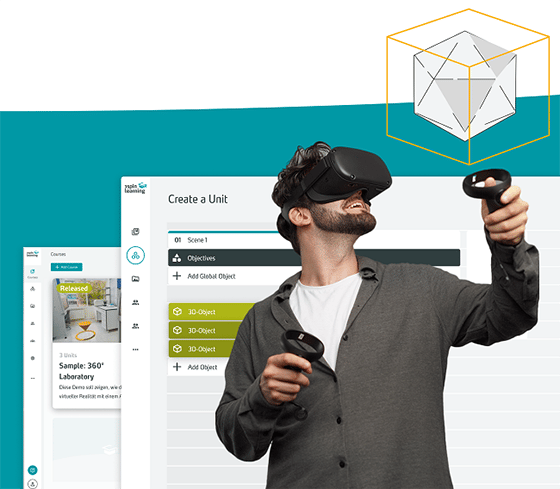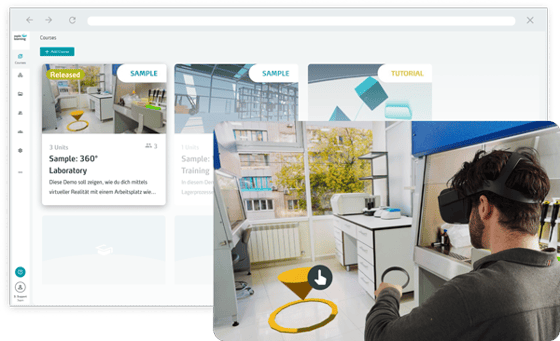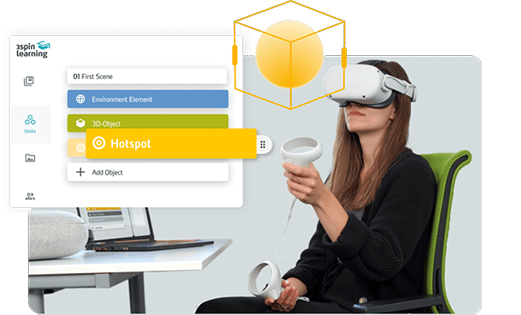The Best Virtual Training Platforms For Your Distance Education
Improve your students' online learning experiences with our guide to choosing the right virtual classroom software.
Reasons why we need learning management systems (LMS) as a powerful educational platform for successful teaching and learning.
A Learning Management System (LMS) is a web-based software application for creating, managing, and distributing educational material. It is often used for digital training - also known as eLearning - which is either designed by the administrators themselves or created with external help.
Finding a learning management system that offers all the features you need without breaking your budget is crucial. In this article, you will find more information and suggestions on how you can benefit from this technology.
A cloud-based online learning platform allows you to learn online without installing a program on a computer or as a webapp on your devices.
In general, a learning management system helps teachers create and deliver content, monitor student participation, and assess student performance. It makes it easier and more scalable for your employees to train, and it consolidates and digitizes all training activities.

Even without an L&D department, the benefits of a learning management system are obvious. A sound learning management system for collaborative learning makes it easy for everyone in the company to create and share learning courses.
Ad hoc solutions such as video tutorials on YouTube, instructional documents, and webinars are not part of an organized learning program. Online learning programs provide efficient and effective training solutions.
The benefits of using an LMS to create more effective online learning programs are not just about a better-informed workforce.
By the way, read more about the benefits of using Virtual Reality here.
With online learning, employees gain more control during the learning process. They can take time to learn complicated concepts or go back and review past modules as needed.
Gain insight into the performance and development of your employees' learning activities and tailor activities specifically to the end user. This allows you to measure the effectiveness of different training programs and allocate training resources more effectively, so you can spend more money on your training.
A learning management system is an investment in your company's continuing education. Although the initial cost may be high, creating online courses that users can access as often as they want is much less expensive than delivering classroom courses. Many large organizations have saved millions of dollars by switching to an online learning model.
Online training is more hands-on than all-day workshops or long training lectures, and it's more fun. The #VyondTheSurface 2020 workplace attitudes study found that 51 percent of employees prefer self-guided online training to instructor-led training.
A solid onboarding process sets the tone for the workplace climate and helps attract and retain new employees. Studies have shown that a comprehensive onboarding process increases the likelihood of employees staying on the job for three years or more by two-thirds.
Collaborative learning platforms engage employees in the training process and course creation.
When creating learning content, modules, and targeted learning opportunities, opportunities also often exist to incorporate them into existing training programs. Other learning types such as microlearning, gamified learning, social learning, and blended learning all play an important role in this context.
The biggest drawback to using a learning management system is that many aspects of training do not adapt to online learning. Many tasks involve developing a physical skill that can't be easily learned or tested online.
Learning how to implement an LMS learning management system can take a lot of time. Transitioning all teachers to eLearning requires a transition period. Many teachers still prefer the traditional way of working with whiteboards and paper handouts over a fully functional LMS system. Even though it is up to the LMS software and IT team to create a user-friendly interface, teachers may still encounter roadblocks during class.
One of the disadvantages of a learning management system is the programming and IT skills required to customize the learning platform to meet instructional needs. Many systems require back-end coding to control the user experience.
Virtual Reality training addresses this by combining cognitive and physical learning.

If you wish to succeed with digital learning, you need to think about the user experience and develop appropriate strategies,
Popular LMS systems among educational institutions are:
Organizations use LMS to create online courses for the training and development of their employees. Some learning management systems require a separate authoring tool for course creation, while others let you create directly on the platform.
Cloud-based LMS systems are hosted in the cloud and often adhere to a software-as-a-service (SaaS) business model. Cloud-based learning management system providers take care of system maintenance and perform any technical updates or upgrades. Online users can access the system from anywhere, at any time, with a username and password.
Self-hosted LMS requires users to download the software. More creative control and customization options are available with the self-hosted platform, but users must maintain the system themselves and often pay for updates.
Desktop applications LMS are installed on the user:s desktop. However, the application can be accessed on multiple devices.
Learning Management System Learning platforms with mobile applications support mobile learning and can be accessed anywhere, anytime via mobile devices. This type of platform deployment allows users to take their online learning initiatives on the go.

Choosing the right LMS system requires thorough forethought to ensure a worthwhile ROI and viable benefits. The following features of a Learning Management System are essential for a better learning experience.
One of the most important aspects of an LMS is its performance in delivering online courses. This is because professionals can use consistent learning programs to control quality and consistency better. Accordingly, videos, SCORM packages, PowerPoint presentations, and text instructions should be kept in a central location.
Thus, the LMS learning platform should accommodate multiple educational resources and adopt a blended learning approach.
SCORM and xAPI are commonly used by LMS solutions to standardize learning content. SCORM and xAPI course files should be instantly uploadable and compatible with the preferred authoring tool with Learning Management System.
By the way, our 3spin Learning Platform offers full xAPI support. For more info on our latest VR & AR features, click here.
Compliance with government regulations and corporate policies is one of the most important tasks. Therefore, when selecting an LMS, it is vital to determine whether the system will provide adequate learner training and assessment within regulatory guidelines.
In addition, a learning management system should track training activities and inform management of any issues that arise.
Before investing in an LMS, check that your company's confidential data is secure. Choose a single-tenant solution thatoffersr you the freedom and data protection you need.
eLearning security and data privacy of your employees are important components of an LMS. Privacy controls, password protected logins and an automatic backup system are the minimum requirements here.
A competent LMS includes details based on previous interactions with the software and position so that broader adoption is encouraged. If a Learner is in a commercial role, for example, that should be able to quickly find other sales-related training content in the LMS Learning Management System.
Users can also use adaptive tests and quizzes to gauge learner performance during a course and, if necessary, prioritize areas for improvement.
Remote work is becoming increasingly popular. An LMS must be remote or mobile-enabled so that learners can access resources at any time and organizations can train their workforce anywhere in the world.
LMS solutions can be used to track training programs and track learners' improvement opportunities or their above-average performance.
Some LMS learning platforms include game-like mechanisms or built-in gamification features that enable teachers and administrators to make courses more motivating and engaging. This can help those students who need an extra incentive to complete the course, possibly in the form of leaderboards, points, and badges.
User management is a very important feature. You can automate actions based on learner profiles in some LMS, and learning content can be pushed to larger parts of the organization based on departments, responsibilities, and job roles.
One of the critical components of an LMS is course design. When purchasing LMS software, make sure they can create the training courses and content themselves, rather than making expensive purchases.
Learning management solutions appeal to a wide range of organizations, including higher education institutions and large enterprises.
Popular use cases are
A great onboarding process sets the tone for your company's work and results in better-prepared employees. Onboarding is even more important for remote businesses, where employees don't have the opportunity to learn from each other in person. Having a solid onboarding process makes up for this knowledge gap and ensures that employees are prepared for both their work and their life at the company.
Soft skills are among the most difficult skills to train. Coursescan be provided to learn conflict resolution, leadership, time management, and more. VR Training is ideal to train people in soft skills.
Sales teams benefit from thorough product training that begins with onboarding and continues throughout a career. Increasingly, learning management systems are being used to facilitate sales training remotely.
A learning management system is ideal for delivering compliance training to mitigate liability and risk for the company. Workplace safety, harassment, and diversity training courses reduce risk and promote a happier, safer work environment.

The different pricing models for learning management systems may include:
This pricing model provides access to the basic features of some LMS learning platforms. Once users need access to the system's more advanced features, a fee is charged.
Users pay a recurring fee for the use of the Learning Management System at regular intervals. With the subscription, organizations either get unlimited access to all LMS features or pay for each individual user.
Licensing is either an
Research conducted by the University of Florida shows that implementing Virtual Reality into training programs improves the user experience many times over and makes the training process more effective. After all, trainees can develop skills faster and remember information more easily.
The major difference between VR and traditional eLearning is that VR allows employees to experience real-life situations. This permits employees to simulate situations in work environments without risk, which would otherwise be too dangerous.
Especially in the areas of health and safety at work, first aid, and fire protection, the many features of a VR learning platform are suitable for legally required training and knowledge refreshment.
Virtual Reality training introduces a whole new dimension to this type of day-to-day and mandatory training, transforming a typically static learning experience into an active learning session.
In this video from our customer Avacon, we demonstrate how the energy company uses our 3spin Learning authoring tool to create and distribute their own learning courses:
A learning management system has the potential to quickly become an indispensable aid in the educational process. It doesn't matter whether the target audience is students or your workforce – virtual learning systems are universal and highly adaptable. There are many solutions on the market that are suitable for companies of different sizes and from different industries.
Collaborative learning is therefore the answer to many challenges in the company and particularly in this area, the investment in Virtual and Augmented Reality training pays off.
For more information on how you can integrate VR & AR into your learning management system, please do not hesitate to contact us here.

Improve your students' online learning experiences with our guide to choosing the right virtual classroom software.
Discover how 3spin Learning's innovative VR features empower organizations to create immersive training courses without coding.
Discover whether VR learning or traditional learning is better suited for the development of your employees.
Stay up to date on new insights in VR / AR learning with AI and build or improve your knowledge within the technology.